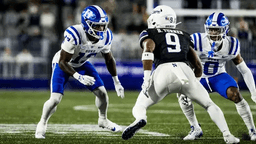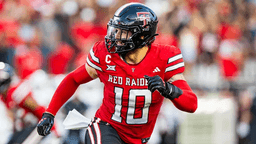Getting to Know the Professional Bull Riders Teams League and the Carolina Cowboys
What is PBR and Who Are the Carolina Cowboys
By: Emmet Mahon · Draft Carolina · 1y

Photo: Courtesy of the PBR
Demand for sports content has never been higher for the American rooting public. No longer is ESPN the primary source to satisfy sports viewership. Numerous national and regional carriers can provide 24 hour access to events. When combined with the booming streaming market, the competition for unique and interesting programming has become a digital arms race. Almost any sports related content can be found somewhere at any given time. One can regularly find detailed gambling and fantasy league experts. Sports unfamiliar to most American fans such as Irish curling or cricket help round out overnight schedules. Of course, the old niche favorite, Australian Rules Football, minus the judges in white hats, enjoys a regular rotation on Fox Sports.
Recognizing this insatiable desire to watch things with a score that is kept, an old sport in a new package has emerged. The PBR (Professional Bull Riders) Teams league is one of the new leagues that is gaining followers faster than Bodacious can throw a cowboy to the dirt. Unlike some of the newer entities like 3Ice or Pickleball, bull riding is no stranger to American television sets. Bull riding first entered sports consciousness when it was featured as part of a segment from the Frontier Days in Cheyene during a segment on ABC’s legendary Wide World of Sports. That segment aired on August 5, 1961. Bull riding was also the backdrop to the life of Lane Frost, who was the subject of the 1994 movie, 8 Seconds.
To help readers better familiarize themselves with this most unique of team sports the PBR has provided us with a comprehensive 101 that hopefully will allow new fans to understand and keep pace with the fast-moving action. In addition to these Questions & Answers, readers can find more information, including scheduling and ticketing information, at PBR.com or the PBR app.
1. When and why was PBR Teams formed?
PBR Teams was launched in 2022, with eight founding teams. Prior to the 2024 season, the league expanded with two new teams joining for its third season beginning in July. PBR Teams builds on the existing structure of professional bull riding with the same basic rules for judging and scoring qualified 8-second bull rides. It’s still a night full of David vs. Goliath 8-second matchups – a 150-pound cowboy taking on a 1,800-pound bull born to buck, only the riders are now on teams versus competing exclusively as individuals. Events are staged in a tournament-style format with all teams competing in head-to-head games against a different opponent each day.
PBR has believed and since proven that the team concept for bull riding is a more engaging format for the casual fan. Bull riding games are easier to understand for anyone familiar with team sports. Also, forming a Team league created the opportunity to bring new investors to bull riding and create brand equity in teams that could build in local markets. As with many sports, teams increase the fans’ rooting interests. Individual bull riding is and remains phenomenal to watch, but it’s very much an insider sport. Team sports are much simpler. Every ride matters.
2. What has fan reaction been to the new league?
PBR CEO and Commissioner Sean Gleason has said PBR Teams is the most successful new league launch in the past 25 years. Expanding from 8 to 10 teams after only two seasons is a strong indication of that. The team format of five-on-five bull riding games has ratcheted up the excitement of an already thrilling sport while attracting a younger audience. Fans in the crowd feel the energy surrounding each home team, and rivalries are building. With wins and losses, a player draft, coaches’ decisions, and a season-ending playoff, fans can more easily engage with our sport. The 2023 Teams Championship in Las Vegas was down-to the wire thrilling and intense, just as you’d find in other team sports.
The league has been a huge success as we head into its third season.
3. Are PBR Camping World Team Series stand alone events, or are they contested in conjunction with touring events?
During the PBR Teams season, the Challenger Series is also in action as the lone domestic individual touring property operated by the PBR. The Challenger Series holds more than 60 events from May-October, culminating with a one-day Championship in Las Vegas. The PBR Challenger Series provides additional competitive opportunities for bull riders who are both affiliated and unaffiliated with a PBR Teams league team.
4. How many teams are there in the Teams league?
PBR Teams launched in 2022 with eight founding teams: Arizona Ridge Riders competing in Glendale, Arizona; Austin Gamblers competing in Austin, Texas; Carolina Cowboys competing in Winston-Salem, North Carolina; Kansas City Outlaws competing in Kansas City, Missouri; Missouri Thunder competing in Ridgedale, Missouri; Nashville Stampede competing in Nashville, Tennessee; Oklahoma Freedom competing in Oklahoma City, Oklahoma; and Texas Rattlers competing in Fort Worth, Texas. Following the 2022 season, the Carolina Cowboys relocated to Greensboro, North Carolina. Following the 2023 season, the Freedom relocated to Sunrise, Florida, becoming the Florida,
Freedom, and the Missouri Thunder moved to Springfield, Missouri. Prior to the start of the 2024 campaign, PBR Teams expanded, adding two teams: New York Mavericks competing in Brooklyn, New York; and Oklahoma Wildcatters competing in Oklahoma City, Oklahoma.
5. How long does the season last?
The season begins in Mid-July and culminates with a multi-day Championship in Late October in Las Vegas.
6. How many events per season?
In 2024, each of the 10 teams will host a multi-day homestand, while the league will also host two, three-day neutral site events in Duluth, Georgia, and Anaheim, California. Following the 12-event regular-season the league will then host a multi-day, progressive elimination Championship tournament in Las Vegas.
7. How are the rosters built. Through a draft, free agency, some other method?
The founding eight teams initially built their rosters through the inaugural PBR Teams Draft, held the day after the 2022 PBR World Finals. During this draft they had the opportunity to draft five riders. Following, teams entered free agency to continue to build out their rosters. In June 2022, Teams then had the opportunity to participate in the Supplemental Draft which featured riders who only declared eligible for a portion of the season. In 2023, Teams then participated in both a New Rider and Reserve Rider Draft. Prior to the 2024 season there will be both an Expansion Draft and New Rider Draft.
8. Do the teams have coaches or managers? Do the teams have their own support staff?
Each team has a front office, support staff and coaching staff, led by a General Manager and Head Coach. The positions vary by team.
9. What about the bulls, do they get assigned to a specific roster or do they rotate from each event?
Much like PBR touring events, the organization’s Livestock Director works to bring the best bulls to every event based on the region of the event. For Teams event, the Livestock Director works diligently to balance each pen so that each team has approximately the same difficulty in bull power. Unlike touring events, where the bulls are assigned via random draw, during Teams events, the pens are drawn at random, and then the Coaches determine which rider from their roster will attempt which bull.
10. Do the bulls win a championship?
Yes, PBR bulls compete for both a YETI “Built for the Wild” High Marked Bull of the Event title, and a year-end YETI PBR World Championship bull title. The World Champion bull title is determined at the World Finals and is inclusive of their performance during both the individual Unleash The Beast season and performance in Teams.
11. Do the bulls get good care?
Every bull ride takes two athletes – a courageous cowboy and world-class bovine. The prized animal athletes competing in professional bull riding are cared for as true stars of the sport.
These bulls born to buck love what they do, are a marvel to watch, and live a great, long life. Contrary to disinformation being spread, the bulls are not shocked, agitated, or tortured. Bucking is in their DNA. They’re the heart of the sport and treated like kings.
12. Is there a Team Series MVP for the riders and the bulls?
There is both an event MVP, awarded both during the regular season and at the Championship, and season MVP title presented to the riders. The event MVP is the top performing rider at each event, while the season MVP is the top performing rider during the regular season. Along with the bull titles explained in question No. 9, during the PBR Teams season, there is a vote amongst fans on the YETI Fan Favorite Bull which is presented prior to the Championship.
13. How long is the season? Where is the championship held? Does it have a special name (Super Bowl, World Series)?
The season lasts from July-October. In 2024, the regular-season will conclude with an expanded, and reformatted four-day, progressive elimination Championship tournament in Las Vegas. Two teams will now need to ride their way into the title-deciding PBR Teams Championship at T-Mobile Arena from October 18-20 and two will go home when the four lowest-ranked teams (No. 7 to No. 10) face off at South Point Hotel & Casino in the one-day Ride-In Round on October 17.
14. Which teams qualify for the championship?
The Top 6 teams following the regular season will automatically qualify for the PBR Teams Championship at T-Mobile Arena, beginning on Oct. 18, with the Top 2 teams receiving a first-round bye. Those teams ranked No. 7-10 will have to compete in the Ride-In Round on Oct. 17 with the two winning teams from the two games advancing to T-Mobile Arena. From Oct. 18-20, the eight teams will then compete through a progressive elimination format before the Teams Champion is crowned on Oct. 20.
15. Is the team championship trophy named after anyone?
While the Teams Championship buckle is not named after anyone, it is an award of epic proportions, weighing approximately 20 pounds and valued at $100,000. Boasting a colossal 24” base made of solid sterling silver that serves as its grandiose platform, it is accented by a sterling silver berry edge that is hand polished and painted. The rich copper and rose gold filigree that weaves throughout the buckle is skillfully engraved by Montana Silversmith’s master craftsmen. The center of the buckle is interchangeable among nine medallions, including the PBR Teams logo, and the mark of each of the league’s founding teams. Once a team has won the buckle, the league logo is swapped out in place of the winning team’s. Each PBR Teams logo was carefully created and precisely painted by hand for the team that will reign victorious.
16. How are the riders scored? How does the team accumulate points?
In the PBR Teams league, teams compete in five-on-five games, with the winning team being the roster of riders with the top combined aggregate score from their five outs. Each ride is worth up to 100 points – 50 points for the bull, and 50 points for the rider if he successfully rides the bull for 8 seconds. Half of the 100 points possible is based on the performance of the bull and how difficult he is to ride. Judges look for bulls with speed, power, and drop in the front end, kick in the back end, direction changes and body rolls. A body roll occurs when a bull is in the air and kicks either his hind hooves or all four hooves to the side.
The more of these characteristics a bull displays during an out, the higher the degree of difficulty. Judges are allowed to award a rider a “re-ride” if they feel the bull did not perform at the level of other bulls in the competition and did not give the rider a fair chance to earn a high score. The other 50 points are based on how adept the rider is. Judges look for constant control and good body position throughout the ride. The rider must stay aboard the bull for 8 seconds to receive a score. The clock begins when the bull’s shoulder or hip crosses the plane of the bucking chute and stops when the bull rider’s hand comes out of the rope or he touches the ground. The bull rider must ride with one hand and is disqualified if he touches himself or the bull with his free arm during the 8-second ride. Rides of 90 points or higher are considered outstanding. The highest score in PBR history is 98.75 points, registered by Jose Vitor Leme aboard Woopaa during the championship round of the 2021 PBR World Finals. During the trip, Leme became the first athlete in PBR history to be awarded a perfect 50 points. At the start of the 2021 season, the previous high marked ride record was 96.5 points. That was exceeded three times in 2021. Leme initially re-wrote the record in late July in Tulsa, Oklahoma, aboard Woopaa when he scored 97.75 points. Dalton Kasel also rode Woopaa for a history-making score in October 2021 – 96.75 points in San Antonio, Texas, now the third-best score in PBR history.
17. Turning to the Cowboys, what is their home arena?
The Carolina Cowboys compete out of Greensboro Coliseum in Greensboro, Coliseum. They will host their third annual Cowboy Days homestand on Sept. 20-22. Tickets are on sale now and can be purchased online at Ticketmaster.com and PBR.com, at the Greensboro Coliseum Box Office, or by calling PBR customer service at 1-800-732-1727.
18. Who is the principal owner of the Cowboys?
The Carolina Cowboys is owned by Richard Childress and Jeff Broin. From a one-man team in 1969, Richard Childress grew Richard Childress Racing (RCR) into one of the most-respected organizations in NASCAR, with nearly 400 team members supporting full-time operations in the NASCAR Cup Series and NASCAR Xfinity Series. As a car owner, Childress, who was inducted into the NASCAR Hall of Fame in 2017, has earned more than 200 victories in NASCAR’s top-three national series, 16 championships, three Daytona 500 championships and three Brickyard 400 championships. Away from the track, Childress is a businessman, philanthropist and conservationist – he loves wine, the outdoors, supporting the military, and investing in America’s youth. Childress’ properties include the award-winning Childress Vineyards. He sits on the board of directors of Growth Energy and holds an honorary doctorate degree from the University of Northwestern Ohio. Entrepreneur and agriculturalist Broin is the founder and CEO of bioprocessing giant POET, the world’s largest biofuel producer. Broin and RCR have a longstanding partnership through NASCAR and worked together to upgrade the league to 15% bioethanol.





Comments:
Log in or sign up to read and post comments.